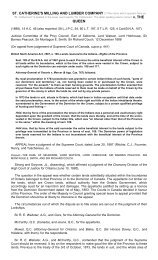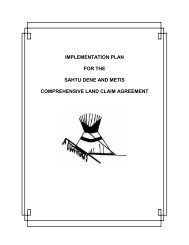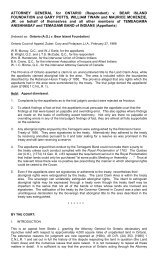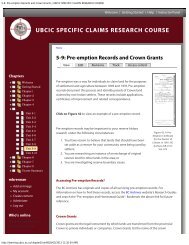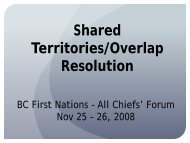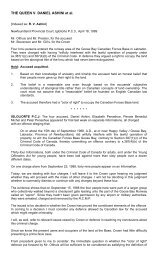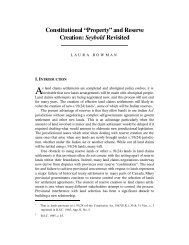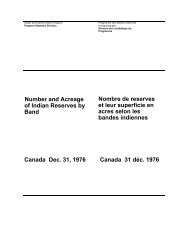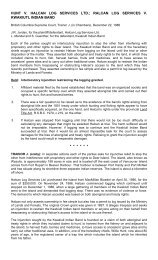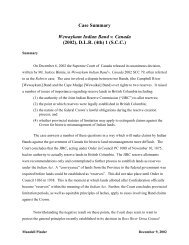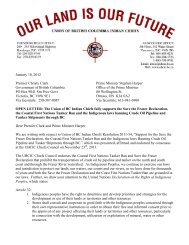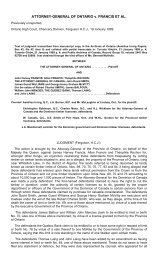exploitation of biodiversity and indigenous knowledge in latin
exploitation of biodiversity and indigenous knowledge in latin
exploitation of biodiversity and indigenous knowledge in latin
- No tags were found...
Create successful ePaper yourself
Turn your PDF publications into a flip-book with our unique Google optimized e-Paper software.
“BIODIVERSITY, GENETIC RESOURCES, ANDINDIGENOUS PEOPLES IN AMAZONIA:(RE) DISCOVERING THE WEALTH OFTRADITIONAL RESOURCES OF NATIVEAMAZONIANS”BYDR. DARRELL ADDISON POSEYInstitute for Cultural <strong>and</strong> Social Anthropology51 Banbury RoadOxford Ox1 3PEU.K.Phone/Fax (44)(1865) 327-358E-Mail: posey@anthropology.ox.ac.uk.Prepared for:AMAZONIA 2000:Development, Environment, <strong>and</strong> Geopolitics24-26 June, 1998Institute <strong>of</strong> Lat<strong>in</strong> American StudiesUniversity <strong>of</strong> London
INTRODUCTIONS<strong>in</strong>ce colonization began, Lat<strong>in</strong> America has provided cheap labour <strong>and</strong> natural resources foreconomically dom<strong>in</strong>ant countries out <strong>of</strong> the region. Indeed, the existent class <strong>and</strong> politicalsystems <strong>of</strong> Lat<strong>in</strong> America are built upon those who provide these resources. Free access <strong>and</strong>uncontrolled <strong>exploitation</strong> <strong>of</strong> flora, fauna, m<strong>in</strong>eral <strong>and</strong> water resources have rema<strong>in</strong>ed criticalto the perceived economic <strong>in</strong>terests <strong>of</strong> Lat<strong>in</strong> American countries.Dur<strong>in</strong>g the last decade, however, a <strong>biodiversity</strong> conservation movement has swept Lat<strong>in</strong>America--<strong>and</strong> the rest <strong>of</strong> the world. Increas<strong>in</strong>gly, countries like Brazil, Costa Rica, Colombia,<strong>and</strong> Mexico have become aware <strong>of</strong> the economic <strong>in</strong>terests Northern countries have <strong>in</strong> their<strong>biodiversity</strong>. Some countries, like Bolivia, Ecuador, <strong>and</strong> Peru had already benefited fromdebt-for-nature swaps, but the “green funds” that were be<strong>in</strong>g transferred from nongovernmentalorganizations (NGOs) <strong>in</strong> the First World to NGOs with<strong>in</strong> their borders defiedgovernmental controls <strong>and</strong> led to suspicions that environmentalism was only a cover forforeign takeover <strong>of</strong> national l<strong>and</strong>s <strong>and</strong> resources. Thus, traditionally, <strong>biodiversity</strong> <strong>and</strong>environmental <strong>in</strong>terests have been viewed with suspicion, or even as threats to nationalsovereignty.Meanwhile, corporate <strong>in</strong>terest <strong>in</strong> new products <strong>and</strong> genetic materials found <strong>in</strong> the components<strong>of</strong> biological diversity has led to a proliferation <strong>of</strong> “<strong>biodiversity</strong> prospect<strong>in</strong>g” 1 (Reid et al,1993; Joyce, 1994; Chadwick & Marsh (ed.), 1994; Posey, 1995). Frequently cited figures<strong>in</strong>dicat<strong>in</strong>g enormous market potential, such as US$ 43 billion per year for sales <strong>of</strong> naturalproductbased pharmaceuticals (Pr<strong>in</strong>cipe, 1989), US$ 50 billion per year for seeds derivedfrom traditional crop varieties (RAFI, 1994: 19), <strong>and</strong> similar figures for other naturalcompounds, led Lat<strong>in</strong> American countries to re-evaluate attitudes toward the value <strong>of</strong> theirflora, fauna, <strong>and</strong> natural resources. It seemed that the traditional governmental policies thatprovoked the unbridled environmental devastation <strong>of</strong> tropical ecosystems might, after all, becontrary to national <strong>in</strong>terests for long term economic growth built upon biotechnology. (Table1 gives a summary <strong>of</strong> past <strong>and</strong> present contributions <strong>of</strong> <strong>biodiversity</strong> rich countries tohumanity.)1 The search for commercially valuable genetic <strong>and</strong> biochemical resources, with particular reference to thepharmaceutical, biotechnological <strong>and</strong> agricultural <strong>in</strong>dustries (Posey & Dutfield, 1996: 14).2
Furthermore, <strong>in</strong>dustry was not only <strong>in</strong>terested <strong>in</strong> genetic resources, but also <strong>in</strong> traditional<strong>knowledge</strong> held by local communities on the utilization <strong>of</strong> flora <strong>and</strong> fauna (Gray, 1991;RAFI, 1994; Chadwick & Marsh, 1994; Posey & Dutfield, 1996; Balick et al (eds.), 1996).Companies like Shaman Pharmaceuticals <strong>and</strong> The Body Shop found that research <strong>and</strong>development costs could be cut by as much as 40%, which -- given that a s<strong>in</strong>gle newmedic<strong>in</strong>e can cost over US$ 200 million to develop -- represents not <strong>in</strong>considerable sav<strong>in</strong>gs(DiMasi et al, 1991).Throughout the history <strong>of</strong> Lat<strong>in</strong> America, <strong><strong>in</strong>digenous</strong> <strong>and</strong> traditional peoples (campes<strong>in</strong>os,caboclos, peons, colonos, caicaras, etc) have been treated--at best--with disda<strong>in</strong> by the rul<strong>in</strong>gelite (Wolf & Hansen, 1972; Wolf, 1982). It was not until the 17th Century that “Indios”were considered to be humans with souls; <strong>and</strong> most western scientists still believe traditional<strong>knowledge</strong> is folklore <strong>and</strong> not scientific. In short, these “backward <strong>and</strong> primitive” peoples arebarriers to development, learn<strong>in</strong>g <strong>and</strong> civilization. Armed with those assumptions,governments--<strong>and</strong> even scientists <strong>and</strong> environmentalists--have found it easy to justify thedispossession <strong>of</strong> Indians <strong>and</strong> peasants from their l<strong>and</strong> <strong>and</strong> resources <strong>in</strong> the name <strong>of</strong>development, conservation, <strong>and</strong> progress. 2It is not surpris<strong>in</strong>g, therefore, that Lat<strong>in</strong> American countries f<strong>in</strong>d it difficult to respond to thepolitical <strong>and</strong> economic problems raised by the global <strong>biodiversity</strong> debate. In short, how can500 years <strong>of</strong> policy to systematically “tame” (read: destroy) the environment <strong>and</strong> <strong><strong>in</strong>digenous</strong><strong>and</strong> traditional communities be reversed <strong>in</strong> time to protect flora, fauna <strong>and</strong> the people whoknow the “secrets” to this new source <strong>of</strong> national wealth? In other words: how canenvironment <strong>and</strong> <strong>biodiversity</strong>--until recently considered subversive concepts--be embracedwithout underm<strong>in</strong><strong>in</strong>g the power <strong>of</strong> the old l<strong>and</strong>-based oligarchies <strong>and</strong> extractive <strong>in</strong>dustrieswhose survival depends on cheap natural <strong>and</strong> human resources?As Lat<strong>in</strong> American countries struggle with these questions, <strong>biodiversity</strong> prospectors <strong>in</strong>vadethe most remote corners <strong>of</strong> jungles, mounta<strong>in</strong>s, <strong>and</strong> coastal reefs--glean<strong>in</strong>g from the publicdoma<strong>in</strong> everyth<strong>in</strong>g they can before national legislation can regulate access <strong>and</strong> transfer <strong>of</strong>genetic resources <strong>and</strong> traditional <strong>knowledge</strong>. By the time most Lat<strong>in</strong> American countries doget around to legislat<strong>in</strong>g on genetic resources <strong>and</strong> traditional <strong>knowledge</strong>, the more aspirant<strong>and</strong> persistent corporations may feel they will have all they need for the development <strong>of</strong> newproducts for a long time to come. “What’s a poor country, rich <strong>in</strong> biological <strong>and</strong> culturaldiversity to do?”INDIGENOUS AND LOCAL COMMUNITIES IN CONSERVATIONThe concept <strong>of</strong> susta<strong>in</strong>ability is embodied <strong>in</strong> <strong><strong>in</strong>digenous</strong> <strong>and</strong> traditional livelihood systems(Posey & Dutfield, 1997). Historical evidence exists which demonstrates the susta<strong>in</strong>edproductivity <strong>of</strong> <strong><strong>in</strong>digenous</strong> systems <strong>in</strong> some cases for thous<strong>and</strong>s <strong>of</strong> years on the same l<strong>and</strong>. 32 A recent publication <strong>of</strong> the World Ra<strong>in</strong>forest Movement (Colchester & Watson, 1995) documents how the<strong><strong>in</strong>digenous</strong> situation has rapidly deteriorated <strong>in</strong> Venezuela. Similarly, recent announcements <strong>in</strong> Brazil <strong>in</strong>dicatethat the Congress is about to re-study the exist<strong>in</strong>g <strong><strong>in</strong>digenous</strong> reserves: a euphemism for reduc<strong>in</strong>g <strong><strong>in</strong>digenous</strong>l<strong>and</strong>s <strong>and</strong> territories to even smaller portions <strong>of</strong> the country than now exist.3 For examples, see D.A. Posey & W. Balée (eds.) (1989) Resource Management <strong>in</strong> Amazonia: Indigenous <strong>and</strong>4
Indigenous peoples <strong>and</strong> traditional communities <strong>of</strong>ten possess a ‘conservation ethic’ 4developed from liv<strong>in</strong>g <strong>in</strong> particular ecosystems (Bierhorst, 1994; Callicott, 1989). This ethiccannot be regarded as universal, but <strong><strong>in</strong>digenous</strong> systems do tend to emphasise the follow<strong>in</strong>gspecific values <strong>and</strong> features (Posey & Dutfield, 1997):• cooperation;• family bond<strong>in</strong>g <strong>and</strong> cross-generational communication, <strong>in</strong>clud<strong>in</strong>g l<strong>in</strong>ks withancestors;• concern for the well-be<strong>in</strong>g <strong>of</strong> future generations;• local-scale, self-sufficiency, <strong>and</strong> reliance on locally available natural resources;• rights to l<strong>and</strong>s, territories <strong>and</strong> resources which tend to be collective <strong>and</strong> <strong>in</strong>alienablerather than <strong>in</strong>dividual <strong>and</strong> alienable; 5• restra<strong>in</strong>t <strong>in</strong> resource <strong>exploitation</strong> <strong>and</strong> respect for nature, especially for sacred sites.The ‘traditional <strong>knowledge</strong>, <strong>in</strong>novations <strong>and</strong> practices’ <strong>of</strong> ‘<strong><strong>in</strong>digenous</strong> <strong>and</strong> local communitiesembody<strong>in</strong>g traditional lifestyles’ are <strong>of</strong>ten referred to by scientists as Traditional EcologicalKnowledge (TEK). 6 TEK is far more than a simple compilation <strong>of</strong> facts. It is the basis forlocal-level decision-mak<strong>in</strong>g <strong>in</strong> areas <strong>of</strong> contemporary life, <strong>in</strong>clud<strong>in</strong>g natural resourcemanagement, nutrition, food preparation, health, education, <strong>and</strong> community <strong>and</strong> socialorganisation. TEK is holistic, <strong>in</strong>herently dynamic, constantly evolv<strong>in</strong>g throughexperimentation <strong>and</strong> <strong>in</strong>novation, fresh <strong>in</strong>sight, <strong>and</strong> external stimuli. Scientists are becom<strong>in</strong>g<strong>in</strong>creas<strong>in</strong>gly aware <strong>of</strong> the sophistication <strong>of</strong> TEK among many <strong><strong>in</strong>digenous</strong> <strong>and</strong> localcommunities. For example, the Shuar people <strong>of</strong> Ecuador’s Amazonian lowl<strong>and</strong>s use 800species <strong>of</strong> plants for medic<strong>in</strong>e, food, animal fodder, fuel, construction, fish<strong>in</strong>g <strong>and</strong> hunt<strong>in</strong>gsupplies (Durn<strong>in</strong>g, 1992: 29). Traditional healers may rely on thous<strong>and</strong>s <strong>of</strong> medic<strong>in</strong>al plants,<strong>and</strong> shift<strong>in</strong>g cultivators throughout the tropics frequently sow more than 100 crops <strong>in</strong> theirforest farms (Ibid).Folk Strategies. Advances <strong>in</strong> Economic Botany, No. 7. New York: New York Botanical Garden; D.M. Warren,L.J. Slikkerveer, <strong>and</strong> D. Brokensha, eds. (1995) The Cultural Dimension <strong>of</strong> Development: IndigenousKnowledge Systems. London: Intermediate Technology Publications; D. Brokensha, D.M. Warren, <strong>and</strong> O.Werner, eds. (1980) Indigenous Knowledge Systems <strong>and</strong> Development. Lanham, MD: University Press <strong>of</strong>America; D.A. Posey <strong>and</strong> G. Dutfield (1996) Indigenous Peoples <strong>and</strong> Susta<strong>in</strong>ability: Cases <strong>and</strong> Actions. Utrecht<strong>and</strong> Gl<strong>and</strong>: International Books <strong>and</strong> International Union for Conservation <strong>of</strong> Nature.4 Johannes <strong>and</strong> Ruddle def<strong>in</strong>e ‘conservation ethic’ as ‘…an awareness <strong>of</strong> people’s ability to deplete or otherwisedamage natural resources, coupled with a commitment to reduce or elim<strong>in</strong>ate the consequences’ (R.E. Johannes<strong>and</strong> K. Ruddle (1993) ‘Human Interactions <strong>in</strong> Tropical Coastal <strong>and</strong> Mar<strong>in</strong>e Areas: Lessons from TraditionalResource Use’. In A. Price <strong>and</strong> S. Humphreys, eds. Applications <strong>of</strong> the Biosphere Reserve Concept to CoastalMar<strong>in</strong>e Areas. Gl<strong>and</strong>: IUCN. Pp. 19-25).5 Accord<strong>in</strong>g to Gray (A. Gray (1994) ‘Territorial Defence as the Basis for Indigenous Self-development’.Indigenous Affairs, 4, pp. 2–3): ‘Indigenous l<strong>and</strong> rights are based on a people’s prior occupation <strong>of</strong> an area,usually before a state was even formed. In this sense, Indigenous peoples have a claim to ‘em<strong>in</strong>ent doma<strong>in</strong>’(<strong>in</strong>alienability) which a state usually considers to be its own exclusive right.... Connected with the concept <strong>of</strong><strong>in</strong>alienability is the collective responsibility which a people has for its territory. This does not mean that<strong>in</strong>dividual persons cannot hold l<strong>and</strong>s <strong>and</strong> resources for their own use, but that personal ownership is based oncollective consent. The collective rights to l<strong>and</strong>s <strong>and</strong> resources <strong>of</strong> Indigenous peoples have been ac<strong>knowledge</strong>dby many governments <strong>of</strong> the world <strong>in</strong> their constitutions <strong>and</strong> <strong>in</strong> <strong>in</strong>ternational provisions’.6 Def<strong>in</strong>ed by Gadgil et al (M. Gadgil, F. Berkes <strong>and</strong> C. Folke (1993: 151) (‘Indigenous Knowledge forBiodiversity Conservation’. Ambio, 22(2-3), pp. 151-156) as ‘A cumulative body <strong>of</strong> <strong>knowledge</strong> <strong>and</strong> beliefsh<strong>and</strong>ed down through generations by cultural transmission about the relationship <strong>of</strong> liv<strong>in</strong>g be<strong>in</strong>gs, (<strong>in</strong>clud<strong>in</strong>ghumans) with one another <strong>and</strong> with their environment’.5
A failure to underst<strong>and</strong> the human-modified nature <strong>of</strong> ‘wild’ l<strong>and</strong>scapes, <strong>in</strong>clud<strong>in</strong>g thosewhich are sparsely populated at the present time, has bl<strong>in</strong>ded outsiders to the managementpractices <strong>of</strong> <strong><strong>in</strong>digenous</strong> peoples <strong>and</strong> local communities (Gomez-Pompa & Kaus, 1992). Manyso-called ‘prist<strong>in</strong>e’ l<strong>and</strong>scapes are <strong>in</strong> fact cultural l<strong>and</strong>scapes, either created by humans ormodified by human activity--such as natural forest management, cultivation, <strong>and</strong> the use <strong>of</strong>fire (Balee 1996; Denevan, 1992; Posey 1997). 7 Indigenous peoples <strong>and</strong> a grow<strong>in</strong>g number <strong>of</strong>scientists believe that it is no longer acceptable simply to assume that just because l<strong>and</strong>scapes<strong>and</strong> species appear to outsiders to be ‘natural’, they are therefore ‘wild’. Accord<strong>in</strong>g to aResolution sponsored by Aborig<strong>in</strong>al peoples at the 1995 Ecopolitics IX Conference <strong>in</strong>Darw<strong>in</strong>, Australia: 8The term ‘wilderness’ as it is popularly used, <strong>and</strong> related concepts as ‘wild resources’,‘wild foods’, etc., [are unacceptable]. These terms have connotations <strong>of</strong> terra nullius[empty or unowned l<strong>and</strong> <strong>and</strong> resources] <strong>and</strong>, as such, all concerned people <strong>and</strong>organisations should look for alternative term<strong>in</strong>ology which does not excludeIndigenous history <strong>and</strong> mean<strong>in</strong>g.For <strong><strong>in</strong>digenous</strong> peoples forests are far more than just a source <strong>of</strong> timber. Most traditionalpeoples who <strong>in</strong>habit forests or areas close to forests rely extensively upon hunted, collected,or gathered foods <strong>and</strong> resources, a significant portion <strong>of</strong> which are <strong>in</strong>fluenced by humans tomeet their needs. These species non-domesticated resources--sometimes also known as‘semi-domesticates’ or ‘human modified species’ (Posey, 1994a, 1997)--form the basis for avast treasury <strong>of</strong> useful species that have systematically been undervalued <strong>and</strong> overlooked byscience, yet provide food <strong>and</strong> medic<strong>in</strong>al security for local communities around the world. 9 Inmany communities children supplement their vitam<strong>in</strong> requirements by gather<strong>in</strong>g fruits, <strong>and</strong>seeds <strong>in</strong> the forests. In many countries there are ancient forest groves which are sacred placesdedicated for rituals, which may also be used for burial sites, <strong>and</strong> as sources <strong>of</strong> medic<strong>in</strong>alplants. Such sites have been found to have conservation importance for the communities <strong>and</strong>to provide other environmental benefits (Posey <strong>and</strong> Dutfield, 1997).Indigenous peoples plant forest gardens <strong>and</strong> manage the regeneration <strong>of</strong> bush fallows <strong>in</strong> wayswhich take advantage <strong>of</strong> natural processes <strong>and</strong> mimic the <strong>biodiversity</strong> <strong>of</strong> natural forests. 10Much <strong>of</strong> the world’s crop diversity is <strong>in</strong> the custody <strong>of</strong> farmers who follow age-old farm<strong>in</strong>g<strong>and</strong> l<strong>and</strong> use practices that conserve <strong>biodiversity</strong> <strong>and</strong> provide other local benefits. Amongsuch benefits are the promotion <strong>of</strong> <strong><strong>in</strong>digenous</strong> diet diversity, <strong>in</strong>come generation, productionstability, m<strong>in</strong>imisation <strong>of</strong> risk, reduced <strong>in</strong>sect <strong>and</strong> disease <strong>in</strong>cidence, efficient use <strong>of</strong> labour,<strong>in</strong>tensification <strong>of</strong> production with limited resources, <strong>and</strong> maximisation <strong>of</strong> returns under lowlevels <strong>of</strong> technology. These ecologically complex agricultural systems associated with centres<strong>of</strong> crop genetic diversity <strong>in</strong>clude traditional cultivars or ‘l<strong>and</strong>races’ that constitute an essentialpart <strong>of</strong> our world crop genetic heritage, <strong>and</strong> non-domesticated plant <strong>and</strong> animal species that7 Accord<strong>in</strong>g to the Four Directions Council (1996): ‘…the territories <strong>in</strong> which <strong><strong>in</strong>digenous</strong> peoples traditionallylive are shaped environments, with <strong>biodiversity</strong> as a priority goal, notwithst<strong>and</strong><strong>in</strong>g the fact that themodifications may be subtle <strong>and</strong> can be confused with the natural evolution <strong>of</strong> the l<strong>and</strong>scape’.8 Northern L<strong>and</strong> Council (1996) Ecopolitics IX: Perspectives on Indigenous Peoples’ Management <strong>of</strong>Environmental Resources. Casuar<strong>in</strong>a, NT: NLC, p.166.9 Such useful species provide most <strong>of</strong> the foods, medic<strong>in</strong>es, oils, essences, dyes, colours, repellents, <strong>in</strong>secticides,build<strong>in</strong>g materials <strong>and</strong> clothes needed by a local community.10 For examples, see A.B. Anderson (ed.) (1990) Alternatives to Deforestation: Steps Toward Susta<strong>in</strong>able Use <strong>of</strong>the Amazon Ra<strong>in</strong> Forest. New York: Columbia University Press.6
serve humanity as biological resources. There are numerous categories <strong>of</strong> traditional<strong>knowledge</strong> among <strong><strong>in</strong>digenous</strong> peoples, which clearly have great potential for application <strong>in</strong> awide range <strong>of</strong> susta<strong>in</strong>ability strategies. Indigenous peoples conserve biological diversity, <strong>and</strong><strong>in</strong> some cases provide other environmental benefits, for example, soil <strong>and</strong> water conservation,soil fertility enhancement, <strong>and</strong> management <strong>of</strong> game <strong>and</strong> fisheries (Posey & Dutfield, 1997).THE CONVENTION ON BIOLOGICAL DIVERSITY AND IPRSThe Convention on Biological Diversity (CBD) was opened for signature dur<strong>in</strong>g the UnitedNations Conference on Conservation <strong>and</strong> Development (UNCED) <strong>in</strong> Rio de Janeiro <strong>in</strong> 1992.It is considered by <strong><strong>in</strong>digenous</strong> peoples to be a sovereignty grab by nation states over allbiological <strong>and</strong> ecological resources.Objectives <strong>of</strong> the Biodiversity Convention, as stated <strong>in</strong> Article 1 are:...the conservation <strong>of</strong> biological diversity, the susta<strong>in</strong>able use <strong>of</strong> its components <strong>and</strong>the fair <strong>and</strong> equitable shar<strong>in</strong>g <strong>of</strong> the benefits aris<strong>in</strong>g out <strong>of</strong> the utilization <strong>of</strong> geneticresources, <strong>in</strong>clud<strong>in</strong>g by appropriate access to genetic resources <strong>and</strong> by appropriatetransfer <strong>of</strong> relevant technologies, tak<strong>in</strong>g <strong>in</strong>to account all rights over those resources<strong>and</strong> technologies, <strong>and</strong> by appropriate fund<strong>in</strong>g.Rights refers to the sovereign rights <strong>of</strong> States. Similarly the beneficiaries <strong>of</strong> equitable shar<strong>in</strong>gare apparently the contract<strong>in</strong>g parties, i.e. the nation states that ratify the CBD), not<strong>in</strong>dividuals or communities. It is important to note, however, that “relevant technologies” canbe <strong>in</strong>terpreted to mean “<strong><strong>in</strong>digenous</strong> <strong>and</strong> traditional technologies” (<strong>in</strong> reference to the language<strong>of</strong> Article 18.4 <strong>in</strong> the “Access to <strong>and</strong> Transfer <strong>of</strong> Technology” Section), or those based upontraditional “<strong>knowledge</strong>, <strong>in</strong>novations <strong>and</strong> practices” (<strong>in</strong> reference to language used <strong>in</strong> Article8.j).Article 8.j states that each Contract<strong>in</strong>g Party must:Subject to its national legislation, respect, preserve <strong>and</strong> ma<strong>in</strong>ta<strong>in</strong> <strong>knowledge</strong>,<strong>in</strong>novations <strong>and</strong> practices <strong>of</strong> <strong><strong>in</strong>digenous</strong> <strong>and</strong> local communities embody<strong>in</strong>gtraditional lifestyles relevant for the conservation <strong>and</strong> susta<strong>in</strong>able use <strong>of</strong>biological diversity <strong>and</strong> promote the wider application with the approval <strong>and</strong><strong>in</strong>volvement <strong>of</strong> the holders <strong>of</strong> such <strong>knowledge</strong>, <strong>in</strong>novations <strong>and</strong> practices <strong>and</strong>encourage the equitable shar<strong>in</strong>g <strong>of</strong> the benefits aris<strong>in</strong>g from the utilization <strong>of</strong>such <strong>knowledge</strong>, <strong>in</strong>novations <strong>and</strong> practices.While <strong><strong>in</strong>digenous</strong> peoples might be flattered with the recognition <strong>of</strong> their relevance to <strong>in</strong> situconservation, they are hardly conv<strong>in</strong>ced that the governments that have tried so hard todestroy them <strong>and</strong> their habitats are now suddenly go<strong>in</strong>g to zealously defend their rights. Theyare also not conv<strong>in</strong>ced that—given their negative experiences <strong>in</strong> the past--any “equitableshar<strong>in</strong>g” will ever trickle down to the source <strong>of</strong> both the <strong>knowledge</strong> <strong>and</strong> resource, i.e., theircommunities. Indigenous leaders are both frustrated <strong>and</strong> angry that while Amazoniancountries do little to protect their <strong>in</strong>terests or guarantee even their most basic rights, they are7
nonetheless now anxious to claim sovereignty over even local <strong>knowledge</strong> systems.Intellectual property rights (IPRs) are assumed by the CBD to be the pr<strong>in</strong>cipal mechanisms toprovide “equitable shar<strong>in</strong>g”, but IPRs are problematic for develop<strong>in</strong>g countries <strong>in</strong> general--<strong>and</strong> <strong><strong>in</strong>digenous</strong>, traditional <strong>and</strong> local communities <strong>in</strong> particular--for the follow<strong>in</strong>g reasons:(i) they are <strong>in</strong>tended to benefit society through the grant<strong>in</strong>g <strong>of</strong> exclusive rights to “natural”<strong>and</strong> “juridical” persons or “creative <strong>in</strong>dividuals”, not collective entities such as <strong><strong>in</strong>digenous</strong>peoples.A group <strong>of</strong> lawyers, academics <strong>and</strong> activists recently summed up the situation thus 11 :Contemporary <strong>in</strong>tellectual property law is constructed around the notion <strong>of</strong> theauthor as an <strong>in</strong>dividual, solitary <strong>and</strong> orig<strong>in</strong>al creator, <strong>and</strong> it is for this figure that itsprotections are reserved. Those who do not fit this model--custodians <strong>of</strong> tribalculture <strong>and</strong> medical <strong>knowledge</strong>, collectives practic<strong>in</strong>g traditional artistic <strong>and</strong>musical forms, or peasant cultivators <strong>of</strong> valuable seed varieties, for example--aredenied <strong>in</strong>tellectual property protection.(ii) they cannot protect <strong>in</strong>formation that does not result from a specific historic act <strong>of</strong>“discovery”. Indigenous <strong>knowledge</strong> is transgenerational <strong>and</strong> communally shared. Knowledgemay come from ancestor spirits, vision quests, or orally-transmitted l<strong>in</strong>eage groups. It isconsidered to be <strong>in</strong> the “public doma<strong>in</strong>” <strong>and</strong>, therefore, unprotectable.(iii) they cannot accommodate complex non-western systems <strong>of</strong> ownership, tenure, <strong>and</strong>access. IPR law assigns authorship <strong>of</strong> a song to a writer or publish<strong>in</strong>g company that canrecord or publish as it sees fit. Indigenous s<strong>in</strong>gers, however, may attribute songs to thecreator spirit <strong>and</strong> elders may reserve the right to prohibit its performance, or to limit it tocerta<strong>in</strong> occasions <strong>and</strong> to restricted audiences.(iv) they serve to stimulate commercialisation <strong>and</strong> distribution, whereas Indigenous concernsmay be primarily to prohibit commercialisation <strong>and</strong> to restrict use <strong>and</strong> distribution. As a 1994COICA (The Coord<strong>in</strong>at<strong>in</strong>g Group <strong>of</strong> the Indigenous Peoples <strong>of</strong> the Amazon Bas<strong>in</strong>) statementputs it:For members <strong>of</strong> <strong><strong>in</strong>digenous</strong> peoples, <strong>knowledge</strong> <strong>and</strong> determ<strong>in</strong>ation <strong>of</strong> the use <strong>of</strong>resources are collective <strong>and</strong> <strong>in</strong>ter-generational. No <strong><strong>in</strong>digenous</strong> population, whether <strong>of</strong><strong>in</strong>dividuals or communities, nor the government, can sell or transfer ownership <strong>of</strong>resources which are the property <strong>of</strong> the people <strong>and</strong> which each generation has anobligation to safeguard for the next.(v) they recognise only market economic values, fail<strong>in</strong>g to consider spiritual, aesthetic, orcultural--or even local economic--values. Information or objects may have their greatest valueto <strong><strong>in</strong>digenous</strong> peoples because <strong>of</strong> their ties with cultural identity <strong>and</strong> symbolic unity.(vi) they are subject to manipulation to economic <strong>in</strong>terests that wield political power. Suigeneris protection has been obta<strong>in</strong>ed for semi-conductor chips <strong>and</strong> “literary works” generated11 The 1993 Bellagio Declaration. In: Boyle, J., 1996. Shamans, S<strong>of</strong>tware <strong>and</strong> Spleens: Law <strong>and</strong> the SocialConstruction <strong>of</strong> the Information Economy. Cambridge: Harvard University Press.8
y computers (Cornish, 1993), whereas <strong><strong>in</strong>digenous</strong> peoples have <strong>in</strong>sufficient power to protecteven their most sacred plants, places, or artefacts.(vii) they are expensive, complicated, <strong>and</strong> time-consum<strong>in</strong>g to obta<strong>in</strong>, <strong>and</strong> even more difficultto defend.There are good reasons why <strong><strong>in</strong>digenous</strong> peoples are worried that <strong>in</strong>tellectual property rightscannot protect their <strong>knowledge</strong> <strong>and</strong> resources. Take for example, the case <strong>of</strong> tiki uba.In a 1988 issue <strong>of</strong> National Geographic Magaz<strong>in</strong>e, Loren McIntyre describes the ‘Last Days<strong>of</strong> Eden’ for the 350 members <strong>of</strong> the Amazonian Urueu-Wau-Wau tribe. They are portrayedas be<strong>in</strong>g vulnerable to diseases carried by outsiders <strong>and</strong> try<strong>in</strong>g to resist the encroachments <strong>of</strong>settlers on their l<strong>and</strong>s. Three photos on one <strong>of</strong> the pages, one <strong>of</strong> which shows a tapir bleed<strong>in</strong>gfrom an arrow wound, are accompanied by the follow<strong>in</strong>g caption (McIntyre 1988:807):Secrets <strong>of</strong> ra<strong>in</strong> forest chemistry provide a feast for the Urueu-Wau-Wau. Us<strong>in</strong>g poisonarrows, they down a young tapir that bubbled <strong>in</strong>to their village at night. Woodenarrow po<strong>in</strong>ts are coated with sap squeezed from the str<strong>in</strong>gy red bark <strong>of</strong> tiki uba trees<strong>and</strong> hardened by fire. An anticoagulant, tiki uba causes victims to bleed to death. Inaddition to such deadly jungle lore, <strong>knowledge</strong> <strong>of</strong> potentially useful foods <strong>and</strong> drugs,accumulated over thous<strong>and</strong>s <strong>of</strong> years, may be lost forever if the forest <strong>and</strong> its<strong>in</strong>habitants disappear.”Jesco von Puttkamer, who took photographs which accompanied the article, was quoted assay<strong>in</strong>g <strong>in</strong> reference to the plant: ‘I th<strong>in</strong>k it may be a great pharmaceutical f<strong>in</strong>d’ (ibid:816).This article attracted the attention <strong>of</strong> researchers work<strong>in</strong>g for the US pharmaceutical companyMerck, <strong>and</strong> von Puttkamer agreed to send them bark <strong>and</strong> sap specimens <strong>in</strong> order for them tocarry out tests (Jacobs et al 1990:31). These tests confirmed that the bark conta<strong>in</strong>ed at leastone compound that <strong>in</strong>hibited enzymes that cause blood clott<strong>in</strong>g <strong>and</strong> efforts immediately beganto commercialize a product useful <strong>in</strong> heart surgery.McIntyre <strong>and</strong> von Puttkamer felt they were act<strong>in</strong>g <strong>in</strong> the best <strong>in</strong>terests <strong>of</strong> humank<strong>in</strong>d whenthey described the tiki uba <strong>in</strong> their article. However, by do<strong>in</strong>g so they made it possible for adrug company to appropriate their <strong>knowledge</strong> without any obligations to compensate theUrueu-Wau-Wau, who, <strong>in</strong> their present situation could well f<strong>in</strong>d compensation highlybeneficial (Posey, Dutfield & Plenderleith, 1995).Another example is illustrated by the <strong>exploitation</strong> <strong>of</strong> a plant called Pilocarpus jabor<strong>and</strong>i totreat glaucoma. Although Brazil now earns US $25 million a year from export<strong>in</strong>g the plant,the Guajajara <strong>in</strong>dians who orig<strong>in</strong>ally provided the “lead” that led to the “discovery” <strong>of</strong> theplant by ethnobotanists now suffer from debt peonage <strong>and</strong> slavery at the h<strong>and</strong>s <strong>of</strong> agents <strong>of</strong>the company <strong>in</strong>volved <strong>in</strong> the trade. Furthermore, the species itself is be<strong>in</strong>g rapidly exhaustedby unsusta<strong>in</strong>able collect<strong>in</strong>g practices (Davis, 1993; P<strong>in</strong>heiro, <strong>in</strong> press).Yet another example <strong>of</strong> commercial <strong>exploitation</strong> <strong>of</strong> <strong><strong>in</strong>digenous</strong> resources is the case <strong>of</strong>patents on <strong><strong>in</strong>digenous</strong> cell l<strong>in</strong>es. Indigenous peoples are particularly disturbed about the“discoveries” made from blood samples (WCIP, 1993). Under the guise <strong>of</strong> “good science”,the Human Genome Organization (HUGO) <strong>and</strong> one <strong>of</strong> its subsidiary projects (the HumanGenome Diversity Project), coord<strong>in</strong>ate the collection <strong>of</strong> blood samples from isolated9
communities like those <strong>in</strong> Amazonia that are “threatened with ext<strong>in</strong>ction” (Cavalli-Sforza etal, 1991). The results will supposedly reveal evolutionary l<strong>in</strong>ks <strong>and</strong> identify geneticsequences for gene therapy to improve human health (HUGO, 1994).The “Vampire Project”, as it is known by <strong><strong>in</strong>digenous</strong> peoples (WCIP, 1993) has broughtmuch discredit to scientific research because, once collected, data <strong>and</strong> cells are available forcommercial <strong>exploitation</strong>. It is likely that collections will be made without the prior <strong>in</strong>formedconsent <strong>of</strong> the sample groups. Indigenous peoples around the world have condemned theProject. 12At least three patent applications have been made for cell l<strong>in</strong>es developed from blood“donated” by <strong><strong>in</strong>digenous</strong> peoples, <strong>in</strong>clud<strong>in</strong>g one from a member <strong>of</strong> a recently-contacted group<strong>of</strong> hunter-cultivators <strong>in</strong> New Gu<strong>in</strong>ea, another from the Solomon Isl<strong>and</strong>s, <strong>and</strong> a third from theGuaymi Indians <strong>of</strong> Panama (Posey & Dutfield, 1996: 25-27). The patent applicant <strong>in</strong> eachcase is the US National Institutes <strong>of</strong> Health, with the government scientists <strong>in</strong>volved <strong>in</strong> theproject named as <strong>in</strong>ventors.These examples illustrate why <strong><strong>in</strong>digenous</strong> communities are less than enthusiastic about <strong>and</strong>trustful <strong>of</strong> scientists. In a now famous declaration from a UNDP Consultation on theProtection <strong>and</strong> Conservation <strong>of</strong> Indigenous Knowledge organized by <strong><strong>in</strong>digenous</strong> groups fromBoliva <strong>and</strong> COICA at Santa Cruz de la Sierra <strong>in</strong> September, 1994, <strong><strong>in</strong>digenous</strong> leadersdeclared a moratorium on all research <strong>and</strong> bioprospect<strong>in</strong>g until appropriate protectionmeasures are <strong>in</strong> place. 13The threat <strong>of</strong> a moratorium is unnerv<strong>in</strong>g, s<strong>in</strong>ce scientists <strong>and</strong> research <strong>in</strong>stitutions are<strong>in</strong>creas<strong>in</strong>gly dependent upon the private sector for their livelihoods. This means the fruits <strong>of</strong>their labours are subject to commercial <strong>exploitation</strong>, or <strong>in</strong>deed, are now designed for thatpurpose (Posey, 1995). It is <strong>of</strong>ten hard for scientists themselves to know when they must wearthe hat <strong>of</strong> their patrons versus the mantle <strong>of</strong> their scientific discipl<strong>in</strong>e. From the <strong><strong>in</strong>digenous</strong>perspective, they (we) are all the same. This means that negotiat<strong>in</strong>g access by scientists to<strong><strong>in</strong>digenous</strong> <strong>and</strong> local communities--whether for bioprospect<strong>in</strong>g or scientific purposes--maytake considerable time <strong>and</strong> energy <strong>and</strong> has become a pr<strong>of</strong>oundly political act (Posey, Dutfield& Plenderleith, 1995). 14The private sector <strong>and</strong> scientific <strong>in</strong>terests are eager that the CBD resolve these dilemmas tobecome an <strong>in</strong>ternational vehicle for clarification <strong>of</strong> the terms <strong>of</strong> access for <strong>and</strong> transfer <strong>of</strong>genetic resources <strong>and</strong> appropriate technologies. Indeed, the CBD has advanced considerablytowards the development <strong>of</strong> guidel<strong>in</strong>es <strong>and</strong> pr<strong>in</strong>ciples for sui generis options to exist<strong>in</strong>g IPRs.The Third Conference <strong>of</strong> the Parties (COP III) <strong>of</strong> the CBD discussed Article 8.j <strong>and</strong>Intellectual Property Rights <strong>and</strong> agreed to “develop national legislation <strong>and</strong> correspond<strong>in</strong>gstrategies for the implementation <strong>of</strong> Article 8.j <strong>in</strong> consultation with representatives <strong>of</strong> their12 For example, <strong><strong>in</strong>digenous</strong> groups from North <strong>and</strong> South America meet<strong>in</strong>g <strong>in</strong> February 1995 promulgated astatement which vigorously condemned the Project. This statement is known as the Declaration <strong>of</strong> IndigenousPeoples <strong>of</strong> the Western Hemisphere Regard<strong>in</strong>g the Human Genome Diversity Project.13 The Statement is pr<strong>in</strong>ted as Appendix 10, pp 219-222, <strong>in</strong> Posey & Dutfield, 1996.14 Significantly, some <strong><strong>in</strong>digenous</strong> groups already have their own policies <strong>and</strong> regulations address<strong>in</strong>g the need tocontrol access to their territories, to monitor the activities <strong>of</strong> plant collectors <strong>and</strong> researchers, <strong>and</strong> to becomebeneficiaries <strong>of</strong> plant collections <strong>and</strong> research. Examples <strong>in</strong> Lat<strong>in</strong> America are the Kuna <strong>of</strong> Panama <strong>and</strong> the Awa<strong>of</strong> Ecuador (see Posey & Dutfield, 1996).10
<strong><strong>in</strong>digenous</strong> <strong>and</strong> local communities” (Decision III/14). An <strong>in</strong>ter-sessional Workshop onTraditional Knowledge <strong>and</strong> Biodiversity was held <strong>in</strong> Madrid <strong>in</strong> November, 1997, <strong>and</strong>proposed to COP-IV that a “participatory mechanism” be established to review legal elementsrelated to benefit-shar<strong>in</strong>g <strong>and</strong> traditional cultural practices for conservation <strong>and</strong> susta<strong>in</strong>ableuse. COP-IV (Decision IV/8) agreed to establish a ”regionally balanced panel <strong>of</strong> experts” todevelop a “common underst<strong>and</strong><strong>in</strong>g <strong>of</strong> basic concepts <strong>and</strong> to explore all options for access <strong>and</strong>benefit shar<strong>in</strong>g on mutually agreed terms <strong>in</strong>clud<strong>in</strong>g pr<strong>in</strong>ciples, guidel<strong>in</strong>es, <strong>and</strong> codes <strong>of</strong> bestpractices for access <strong>and</strong> benefit shar<strong>in</strong>g arrangements”. Decision IV/9 on Implementation <strong>of</strong>Article 8(j) <strong>and</strong> Related Provisions specifically recognised the “importance <strong>of</strong> mak<strong>in</strong>g<strong>in</strong>tellectual property-related provisions <strong>of</strong> the Convention on Biological Diversity <strong>and</strong>provisions <strong>of</strong> <strong>in</strong>ternational agreements relat<strong>in</strong>g to <strong>in</strong>tellectual property mutually supportive,<strong>and</strong> the desirability <strong>of</strong> undertak<strong>in</strong>g further cooperation <strong>and</strong> consultation with the WorldIntellectual Property Organization”. The decision also agreed to establish an “ad hoc openended<strong>in</strong>ter-sessional work<strong>in</strong>g group” to address IPR <strong>and</strong> issues related to Article 8.j 15 .Whatever the CBD recommends, however, it is important to remember that States themselvesare responsible for adequate national legislation to govern access to <strong>and</strong> transfer <strong>and</strong> use <strong>of</strong>their genetic resources <strong>and</strong> traditional technologies with<strong>in</strong> their sovereign boundaries. Thefollow<strong>in</strong>g section looks at some efforts <strong>in</strong> Lat<strong>in</strong> American <strong>and</strong> Amazonian countries.NATIONAL AND REGIONAL INITIATIVESA number <strong>of</strong> <strong>in</strong>itiatives are underway <strong>in</strong> Lat<strong>in</strong> American <strong>and</strong> Amazonian countries to f<strong>in</strong>dadequate protection <strong>of</strong> genetic <strong>and</strong> <strong>knowledge</strong>. The overall goal is to f<strong>in</strong>d legal ways <strong>of</strong>susta<strong>in</strong>ably exploit<strong>in</strong>g <strong>biodiversity</strong> <strong>in</strong> a commercial, yet equitable manner. Most <strong>of</strong> what ishappen<strong>in</strong>g <strong>in</strong> Amazonia has been guided by experiences <strong>in</strong> other parts <strong>of</strong> Lat<strong>in</strong> America, forexample:1. Costa RicaCosta Rica is hardly an Amazonian country, but it has led the way <strong>in</strong> Lat<strong>in</strong> America (<strong>and</strong>beyond) on issues <strong>of</strong> access <strong>and</strong> transfer legislation, equitable benefit-shar<strong>in</strong>g, <strong>and</strong> protection<strong>of</strong> genetic resources. Perhaps the best know example <strong>of</strong> “equitable arrangements” is theMerck-INBio agreement. The National Biodiversity (INBio), an NGO closely l<strong>in</strong>ked with thegovernment, was established to carry out a species <strong>in</strong>ventory <strong>of</strong> the country <strong>and</strong> to explore thecommercial potential <strong>of</strong> biological resources with corporations through Material TransferAgreements (MTAs). Accord<strong>in</strong>g to Costa Rican law, the biological diversity <strong>of</strong> the country onpublic <strong>and</strong> private l<strong>and</strong>s is national patrimony <strong>and</strong> the State has the exclusive right to grantpermits to organisations such as INBio to <strong>in</strong>vestigate, collect <strong>and</strong> exploit the country’sbiological resources with<strong>in</strong> its Conservation Areas 16 .15 Dutfield, G. 1998, “Background Paper on Intellectual Property Rights <strong>in</strong> the Context <strong>of</strong> Seeds <strong>and</strong> PlantVarieties”, an unpublished Report for the IUCN Project on The Convention on Biological Diversity <strong>and</strong> TheInternational Trade Regime, IUCN/Gl<strong>and</strong>.16 For greater detail, see Posey & Dutfield, 1996, Beyond Intellectual Property Rights, IDRC.11
The agreement between Merck <strong>and</strong> INBio provides the latter with an advanced payment <strong>of</strong> $1million <strong>and</strong> royalties <strong>in</strong> case a product is derived from any <strong>of</strong> the extracts which INBio willtransfer to Merck. 50% <strong>of</strong> the royalties are to be forwarded to the government’s NationalParks Fund.There were several problems with this <strong>in</strong>itial approach:i) The government claims sovereignty over the country’s <strong>biodiversity</strong> <strong>and</strong> does notrecognise the territorial <strong>and</strong> resources rights <strong>of</strong> <strong><strong>in</strong>digenous</strong> peoples <strong>and</strong> local communities.ii) INBio has secured prospect<strong>in</strong>g rights to l<strong>and</strong>s which accord<strong>in</strong>g to national laws areunder State ownership, permitt<strong>in</strong>g very little <strong>in</strong> the way <strong>of</strong> local control. In fact, the Director<strong>of</strong> INBio was unaware that there were <strong><strong>in</strong>digenous</strong> peoples <strong>in</strong> the country--although theagreement was for collect<strong>in</strong>g on national l<strong>and</strong>s, <strong>in</strong>clud<strong>in</strong>g those <strong>of</strong> eight <strong><strong>in</strong>digenous</strong> peoples.iii) Although the agreement with Merck provides benefits for the government <strong>and</strong> forINBio, no benefits will go to local communities except for the tra<strong>in</strong><strong>in</strong>g <strong>of</strong> a small <strong>of</strong> “parataxonomists”.Furthermore, INBio will not contribute at all to revitalis<strong>in</strong>g local <strong>knowledge</strong>traditions because it pr<strong>of</strong>esses to have no <strong>in</strong>terest at all <strong>in</strong> such <strong>knowledge</strong>.iv) Although the advance payment by Merck seems substantial, it is hardly generous;neither are the agreed royalty percentage <strong>of</strong> between 3-4%).v) There is no provision <strong>in</strong> the agreement for co-ownership <strong>of</strong> patents (Joyce, 1994:126-127). Therefore, Merck will have exclusive <strong>in</strong>tellectual property rights.S<strong>in</strong>ce this historic agreement, INBio has made numerous other agreements with Merck <strong>and</strong>other pharmaceutical <strong>and</strong> natural product companies that have confronted some <strong>of</strong> these basicproblems (Mateo 1998). The Merck-INBio experience was <strong>in</strong>strumental <strong>in</strong> development <strong>of</strong>Costa Rica’s new (April, 1998) Ley de Biodiversidad, which has become one <strong>of</strong> the “mostambitions <strong>and</strong> elaborate national laws” for Lat<strong>in</strong> America (Dutfield, 1998). The Ley deBiodiversidad seeks to implement the provisions <strong>of</strong> the CBD <strong>and</strong> to develop “a sui generissystem to protect the <strong>in</strong>tellectual rights <strong>of</strong> <strong><strong>in</strong>digenous</strong> peoples <strong>and</strong> local communities” (ibid).There are 13 overall objectives <strong>of</strong> the Ley, summarised below, <strong>and</strong> these will surely be<strong>in</strong>fluential <strong>in</strong> guid<strong>in</strong>g legislative activities <strong>in</strong> Amazonian countries attempt<strong>in</strong>g to control theloss <strong>of</strong> genetic <strong>and</strong> <strong>knowledge</strong> resources from the region.12
Pr<strong>in</strong>ciples <strong>and</strong> objectives <strong>of</strong> the Ley de Biodiversidad(Costa Rica, 1998)General pr<strong>in</strong>ciples1. Respect for all forms <strong>of</strong> life – all liv<strong>in</strong>g th<strong>in</strong>gs have the right to life <strong>in</strong>dependent <strong>of</strong> theiractual or potential economic value.2. The elements <strong>of</strong> <strong>biodiversity</strong> are meritorious – they have decisive <strong>and</strong> strategicimportance for the country’s development <strong>and</strong> are essential for the domestic, social,cultural <strong>and</strong> aesthetic use <strong>of</strong> its <strong>in</strong>habitants.3. Respect for cultural diversity – the diversity <strong>of</strong> cultural practices <strong>and</strong> associated<strong>knowledge</strong> <strong>of</strong> <strong>biodiversity</strong> elements must be respected <strong>and</strong> promoted, <strong>in</strong> conformity withnational <strong>and</strong> <strong>in</strong>ternational juridical st<strong>and</strong>ards, particularly <strong>in</strong> the case <strong>of</strong> peasantcommunities, <strong><strong>in</strong>digenous</strong> peoples <strong>and</strong> other cultural groups.4. Intra- <strong>and</strong> <strong>in</strong>ter-generational equity – the State <strong>and</strong> private <strong>in</strong>dividuals will ensure that<strong>biodiversity</strong> elements are utilised susta<strong>in</strong>ably <strong>in</strong> such a way that the possibilities <strong>and</strong>opportunities from their use <strong>and</strong> the benefits are guaranteed <strong>in</strong> a just manner for all sectors<strong>of</strong> society <strong>and</strong> to satisfy the needs <strong>of</strong> future generations.Objectives (selected)1. To <strong>in</strong>tegrate conservation <strong>and</strong> susta<strong>in</strong>able use <strong>of</strong> <strong>biodiversity</strong> elements <strong>in</strong>to thedevelopment <strong>of</strong> socio-cultural, economic <strong>and</strong> environmental policies.2. To promote active participation <strong>of</strong> all social sectors <strong>in</strong> conservation <strong>and</strong> ecologicallysusta<strong>in</strong>able use <strong>of</strong> <strong>biodiversity</strong>, <strong>in</strong> pursuit <strong>of</strong> social, economic <strong>and</strong> cultural susta<strong>in</strong>ability.3. To regulate access <strong>and</strong> facilitate equitable distribution <strong>of</strong> social, environmental <strong>and</strong>economic benefits for all sectors <strong>of</strong> society, with special attention to local communities<strong>and</strong> <strong><strong>in</strong>digenous</strong> peoples.4. To recognise <strong>and</strong> compensate the <strong>knowledge</strong>, <strong>in</strong>novations <strong>and</strong> practices <strong>of</strong> <strong><strong>in</strong>digenous</strong>peoples <strong>and</strong> local communities for conservation <strong>and</strong> ecologically susta<strong>in</strong>able use <strong>of</strong><strong>biodiversity</strong> elements.5. To recognise rights aris<strong>in</strong>g from the contribution <strong>of</strong> scientific <strong>knowledge</strong> for conservation<strong>and</strong> ecologically susta<strong>in</strong>able use <strong>of</strong> <strong>biodiversity</strong> elements.6. To promote access to <strong>biodiversity</strong> elements <strong>of</strong> <strong>biodiversity</strong> <strong>and</strong> technology transfer.7. To foster <strong>in</strong>ternational <strong>and</strong> regional cooperation to achieve conservation, ecologicallysusta<strong>in</strong>able use <strong>and</strong> distribution <strong>of</strong> benefits derived from <strong>biodiversity</strong>, especially <strong>in</strong>frontier areas or shared resources.From: G. Dutfield, 1998 (IUCN Report)2. The Andean PactSome Lat<strong>in</strong> American countries, for example the Andean Pact countries, have responded withdraft legislation <strong>in</strong>tended to establish equitable terms for grant<strong>in</strong>g access to genetic resources<strong>and</strong> shar<strong>in</strong>g benefits with <strong><strong>in</strong>digenous</strong> peoples. The Andean Community Common System on13
Access to Genetic Resources was adopted by member states (Bolivia, Colombia, Ecuador,Peru <strong>and</strong> Venezuela) <strong>in</strong> 1996.The basic terms <strong>of</strong> the Common System <strong>in</strong>clude:i) shar<strong>in</strong>g <strong>of</strong> benefits between receivers <strong>of</strong> biological resources, members states <strong>and</strong>providers, which may be legal entities, private <strong>in</strong>dividuals, or <strong><strong>in</strong>digenous</strong> or localcommunities;ii) restrictions on transfer to third parties;iii) report<strong>in</strong>g on obligations on future uses;iv) obligations related to <strong>in</strong>tellectual property;v) exclusivity <strong>and</strong> confidentiality;vi) recognition <strong>of</strong> the Member States or provider <strong>in</strong> the publication <strong>of</strong> research results.Member States would recognise the rights <strong>of</strong> <strong><strong>in</strong>digenous</strong> <strong>and</strong> local communities over their<strong>knowledge</strong>, <strong>in</strong>novations <strong>and</strong> practices, <strong>and</strong> would concede to local communities the “authorityto decide whether <strong>and</strong> how to share such <strong>knowledge</strong>, <strong>in</strong>novations <strong>and</strong> practices”.Andean Pact countries, as well as Brazil, ascribe <strong>biodiversity</strong> to the national patrimony.However, it is unclear if States (governments) have the exclusive rights to determ<strong>in</strong>e access<strong>and</strong> set terms for transfer <strong>and</strong> benefit-shar<strong>in</strong>g. It is equally unclear what authority local, state<strong>and</strong> regional governments have vis a vis national or federal governments. In the absence <strong>of</strong>clear laws on genetic resources, most countries f<strong>in</strong>d they are <strong>in</strong>capable <strong>of</strong> limit<strong>in</strong>g access oreven monitor<strong>in</strong>g activities with<strong>in</strong> their borders.One very significant aspect <strong>of</strong> the Andean Common System on Access to Genetic Resources isthat protection is extended to derivatives, which are def<strong>in</strong>ed as “a molecule or comb<strong>in</strong>ation<strong>of</strong> mixture <strong>of</strong> natural molecules, <strong>in</strong>clud<strong>in</strong>g raw extracts <strong>of</strong> liv<strong>in</strong>g or dead organisms <strong>of</strong>biological orig<strong>in</strong>, derived from the metabolism <strong>of</strong> liv<strong>in</strong>g organisms” (Dutfield, 1998).Although this does not cover synthetic products developed from artificial processes us<strong>in</strong>ggenetic <strong>in</strong>formation or molecules, it does claim ownership over compounds that are isolatedfrom nature, even if the laboratory work is done outside the Andean countries.The Common System also recognises “<strong>in</strong>tangible components”, such as “<strong>knowledge</strong>,<strong>in</strong>novations, <strong>and</strong> practices” (<strong>in</strong>dividual or collective) that are <strong>of</strong> actual or potential value.These components--<strong>and</strong> their derivatives--are also protected <strong>and</strong> regulated by national laws,which require legally recognised licenses <strong>and</strong> contracts registered with the “CompetentNational Authority”. Any <strong>and</strong> all products, patents or claims that do not have such a licenseare not protectable nor recognised by Andean countries.It should be noted that, <strong>in</strong> addition to the Common System, some Andean countries areexperiment<strong>in</strong>g with other forms <strong>of</strong> Intellectual Property Rights. For example, Ecuador hastaken steps to establish a “<strong>biodiversity</strong> cartel” that would claim monopoly rights by the Stateover all biological diversity. The genetic resources would be protected under trade secret law14
<strong>and</strong> licensed for royalties to <strong>in</strong>terested users (Vogel, 1996) 17 . In Peru, the Aguaruna peoplehave utilised know-how law to successfully license their traditional <strong>knowledge</strong> for the use <strong>of</strong>genetic resources by an International Cooperative Biodiversity Group Program (ICBG)project with Wash<strong>in</strong>gton Unversity (USA), two Peruvian Universities <strong>and</strong> Searle & Co.pharmaceuticals, which is part <strong>of</strong> Monsanto (Tob<strong>in</strong>, 1996) 18 .3. BRAZILOne <strong>of</strong> the first <strong>and</strong> most historic attempts <strong>in</strong> Amazonia to implement the CBD <strong>in</strong> a mannerthat would support the objectives <strong>of</strong> Article 8.j occurred <strong>in</strong> Brazil with Proposed Law (PL2057/91). The proposal was approved <strong>in</strong> 1994 by the Chamber <strong>of</strong> Deputies <strong>of</strong> the nationallegislature, but has never passed <strong>in</strong>to the Senate <strong>and</strong> is still under consideration for itsconstitutionality. The proposed law is <strong>in</strong>tended to protect <strong>and</strong> assure respect for <strong><strong>in</strong>digenous</strong>peoples’ social organisation, customs, languages, beliefs <strong>and</strong> traditions, <strong>and</strong> rights over theirterritories <strong>and</strong> possessions.Articles 18-29 deal with the <strong>in</strong>tellectual property <strong>of</strong> <strong><strong>in</strong>digenous</strong> peoples. Among the importantprovisions <strong>of</strong> potential benefit to <strong><strong>in</strong>digenous</strong> peoples are the follow<strong>in</strong>g:--the right to ma<strong>in</strong>ta<strong>in</strong> the secrecy <strong>of</strong> traditional <strong>knowledge</strong>;--the right to refuse access to traditional <strong>knowledge</strong>;the right to apply for IPR protection, which, <strong>in</strong> the case <strong>of</strong> collective <strong>knowledge</strong> willbe granted <strong>in</strong> the name <strong>of</strong> the community or society;--the right <strong>of</strong> prior <strong>in</strong>formed consent (to be given <strong>in</strong> writ<strong>in</strong>g) for access to, use <strong>of</strong> <strong>and</strong>application <strong>of</strong> traditional <strong>knowledge</strong>;--the right to co-ownership <strong>of</strong> research data, patents <strong>and</strong> products derived from theresearch but without the community hav<strong>in</strong>g to pay patent fees;--<strong>and</strong>, the right <strong>of</strong> communities to nullify patents illegally derived from their<strong>knowledge</strong>.The Act would redef<strong>in</strong>e patents <strong>and</strong> copyright by allow<strong>in</strong>g community IPR to cont<strong>in</strong>uewithout time limit.There is little surprise that such a revolutionary bill would have run <strong>in</strong>to troubles <strong>in</strong> theBrazilian Congress, especially given the heavy <strong>and</strong> unrelent<strong>in</strong>g pressures from <strong>in</strong>dustrialcountries to implement a st<strong>and</strong>ard (U.S. style) IPR regime 19 . Brazil has had patent law s<strong>in</strong>ce1887 <strong>and</strong> established a National Institute for Industrial Property (INPI) <strong>in</strong> 1971 to adm<strong>in</strong>ister17 Joseph Vogel is a consultant for the InterAmerican Development Bank-Consejo Nacional de Desarrollo.His address is Eloy Alfaro 266 y Berl<strong>in</strong>, 102, Quito, Ecuador. E-mail: joevogel@vogel.ecx.ec18 Brendan Tob<strong>in</strong> can be reached at the Sociedad Peruana de Derecho Ambiental, Plaza Arrospide No. 9, SanIsidro, Lima 27, Peru. Tel: +51 14 40 0549; fax: +51 14 42 4365; e-mail: manolo@spda2.org.pe19 Considerable <strong>in</strong>formation can be obta<strong>in</strong>ed on the political processes (civil <strong>and</strong> governmental) by check<strong>in</strong>gthe materials distributed by David Hathaway, who coord<strong>in</strong>ated the genetics network <strong>of</strong> Brazil. Contact address:hathaway@netflash.com.br15
its “modern” Industrial Property Code (Law 5772/71). This law was replaced <strong>in</strong> May, 1997,by Law 9297 that “streaml<strong>in</strong>es” <strong>in</strong>dustrial property protection <strong>and</strong> strengthens patents for<strong>in</strong>dustrial property 20 . There is no mention <strong>of</strong> collective property, community resources, ortraditional technologies <strong>of</strong> <strong><strong>in</strong>digenous</strong> <strong>and</strong> local peoples.Dur<strong>in</strong>g the past two years, however, Senadora Mar<strong>in</strong>a da Silva has sponsored public hear<strong>in</strong>gsthroughout Brazil on legislation govern<strong>in</strong>g access to genetic resources. These hear<strong>in</strong>g haveled to a greater public underst<strong>and</strong><strong>in</strong>g <strong>of</strong> “biopiracy” <strong>and</strong> “bioprospection”—<strong>and</strong>, along with it,a grown<strong>in</strong>g concern about how Brazil, <strong>and</strong> more specifically, Brazilians are be<strong>in</strong>g “ripped<strong>of</strong>f” 21 . The Senadora’s f<strong>in</strong>d<strong>in</strong>gs have been encompassed <strong>in</strong> Lei 306/95 govern<strong>in</strong>g “Acesso aosRecursos Biologicos e Geneticos”, which was approved by the Senate <strong>in</strong> June, 1998, but hasyet to be debated by the House <strong>of</strong> Deputies. There is a proposal by the Casa Civil to removereference to community <strong>and</strong> property rights for <strong><strong>in</strong>digenous</strong> <strong>and</strong> traditional communities,aga<strong>in</strong>, it is claimed, so as not to conflict with exist<strong>in</strong>g <strong>in</strong>dustrial property legislation 22 .Under the Brazilian Constitution <strong>of</strong> 1988, federal States have greater autonomy. The State <strong>of</strong>Acre, tired <strong>of</strong> await<strong>in</strong>g national action, enacted its own Lei de Accesso aos RecursosGeneticos (Projeto de Lei No 15/97) <strong>in</strong> 1997. The law draws upon the Andean CommonSystem <strong>and</strong> the PL 2057/91. It recognises the collective rights <strong>of</strong> <strong><strong>in</strong>digenous</strong> <strong>and</strong> localpeoples over their genetic resources <strong>and</strong> traditional <strong>knowledge</strong>. It also regulates collection <strong>of</strong>genetic materials for “research, bioprospect<strong>in</strong>g, conservation, <strong>in</strong>dustrial application,commercial use, <strong>and</strong> other purposes” <strong>and</strong> requires equitable <strong>and</strong> adequate benefit-shar<strong>in</strong>gfrom such materials <strong>and</strong> collections. The Secretaria de Estado de Ciencia, Tecnologia e MeioAmbiente (SECTMA) do Acre becomes the body responsible for licens<strong>in</strong>g, monitor<strong>in</strong>g, <strong>and</strong><strong>in</strong>itiation <strong>of</strong> legal action, s<strong>in</strong>ce one <strong>of</strong> the most <strong>in</strong>terest<strong>in</strong>g <strong>and</strong> historical aspects <strong>of</strong> the Lei isthat <strong>in</strong>fr<strong>in</strong>gements <strong>of</strong> the law carry crim<strong>in</strong>al penalties.In November, 1997, Deputada Socorro Gomes (Para) presided over the Commissao ExternaCriada para Apurar Denunicas de Exploracao e Comercializacao Ilegal de Plantas e MaterialGenetico na Amazonia, which reports to a special Commissao de Biopirararia. The reportcalls for more rigorous laws to control “Biopiracy”, <strong>in</strong>clud<strong>in</strong>g exp<strong>and</strong>ed crim<strong>in</strong>al charges forunauthorised collection, <strong>exploitation</strong>, <strong>and</strong> use <strong>of</strong> genetic resources <strong>and</strong> traditional <strong>knowledge</strong>about them.The idea that genetic resources <strong>and</strong> traditional ecological <strong>knowledge</strong> are resources for States<strong>and</strong> the Union is <strong>in</strong>deed a major change <strong>in</strong> the history <strong>of</strong> Brazil—<strong>and</strong>, <strong>in</strong>deed, <strong>of</strong> Lat<strong>in</strong>America. Until very recently it would have been <strong>in</strong>conceivable that a CongressionalCommission would be established to <strong>in</strong>vestigate illegal <strong>exploitation</strong> <strong>of</strong> plants, animals <strong>and</strong>traditional <strong>knowledge</strong>. It seems that times have <strong>in</strong>deed changed <strong>in</strong> Amazonia!CONCLUSIONS20 A critique <strong>of</strong> this law <strong>and</strong> other implement<strong>in</strong>g mechanisms (regulatory acts), as well as complete texts <strong>of</strong> thelaw <strong>in</strong> English, French <strong>and</strong> Portuguese, can be found on the INPI Web Site: http://www.<strong>in</strong>pi.gov.br//.21 See: Pat Mooney, cited <strong>in</strong> Genetic Ownership: Brazil Wants Cut <strong>of</strong> Its Biological Bounty, by ElizabethPennisi, Science 279, No 5356, Issue 6 March, 1998, p 1445; <strong>and</strong> elsewhere).22 Personal communication, David Hathaway, 14 July, 1998.16
The political legacy <strong>in</strong> Lat<strong>in</strong> America <strong>of</strong> ruthless <strong>exploitation</strong> <strong>of</strong> natural resources lead<strong>in</strong>g toecological destruction--<strong>and</strong> the systematic annihilation <strong>and</strong> marg<strong>in</strong>alization <strong>of</strong> <strong><strong>in</strong>digenous</strong>,traditional <strong>and</strong> local communities—have left countries unprepared to deal with economic <strong>and</strong>political issues raised by global <strong>biodiversity</strong> developments. Although Nation/States haveacted to declare sovereign rights over flora, fauna, <strong>and</strong> appropriate technologies forsusta<strong>in</strong>able development <strong>and</strong> <strong>biodiversity</strong> conservation, legal structures <strong>and</strong> political<strong>in</strong>stitutions are <strong>in</strong>adequate or non-existent to protect, monitor, or control access <strong>and</strong> transfer.Some recent efforts by Brazil <strong>and</strong> the Andean Pact to establish regimes that control access<strong>and</strong> protect traditional resources are fundamentally radical <strong>in</strong> that they recognize thecollective <strong>and</strong> community-based nature <strong>of</strong> <strong>in</strong> situ <strong>biodiversity</strong> conservation--which impliesrecognition <strong>of</strong> <strong><strong>in</strong>digenous</strong> l<strong>and</strong>, territorial, <strong>and</strong> resource rights. These rights are sometimessubsumed under the rubric <strong>of</strong> self-determ<strong>in</strong>ation, historically seen by Lat<strong>in</strong> Americancountries as a threat to their national sovereignty. However, with the rampant loss <strong>of</strong> geneticresources <strong>and</strong> traditional <strong>knowledge</strong> though <strong>biodiversity</strong> prospect<strong>in</strong>g--by national,<strong>in</strong>ternational, <strong>and</strong> mult<strong>in</strong>ational <strong>in</strong>terests—Nation/States may have to forge equitablepartnerships with <strong><strong>in</strong>digenous</strong> peoples <strong>in</strong> order to atta<strong>in</strong> local access to <strong>knowledge</strong>, flora <strong>and</strong>fauna.The grow<strong>in</strong>g political awareness <strong>and</strong> effective <strong>in</strong>ternational organization <strong>of</strong> <strong><strong>in</strong>digenous</strong>groups--comb<strong>in</strong>ed with the ethical, moral <strong>and</strong> legal concerns <strong>of</strong> scientists co-opted bycommercial concerns--means that actions to develop pr<strong>in</strong>ciples <strong>and</strong> guidel<strong>in</strong>es for access,transfer <strong>and</strong> benefit-shar<strong>in</strong>g will no longer await government paralysis. By the time Lat<strong>in</strong>Amazonian governments actually do act to protect traditional resources, they may f<strong>in</strong>d theirsovereign rights underm<strong>in</strong>ed by research moratoria, private corporations, governmententrepreneurs, <strong>and</strong> extensive data banks <strong>of</strong> “national patrimony” be<strong>in</strong>g beamed around theplanet on the Internet.It is unclear how <strong>biodiversity</strong> <strong>and</strong> biotechnology will <strong>in</strong>fluence economic development <strong>in</strong>Amazonia--but it is certa<strong>in</strong> that “bus<strong>in</strong>ess as usual” will only lead to <strong>in</strong>creased underm<strong>in</strong><strong>in</strong>g<strong>of</strong> national sovereignty over traditional resources. The recent flurry <strong>of</strong> activities <strong>and</strong> Projetosde Lei may <strong>in</strong>dicate dramatic changes <strong>in</strong> how Amazonian countries view their human <strong>and</strong>genetic resources, but it rema<strong>in</strong>s to be seen if the economic <strong>in</strong>terests <strong>and</strong> public <strong>in</strong>dignation <strong>of</strong>“biopiracy” translate <strong>in</strong>to practical policies that improve the conditions <strong>of</strong> local, traditional,<strong>and</strong> <strong><strong>in</strong>digenous</strong> peoples <strong>of</strong> Amazonia.17
BibliographyAnderson, A.B., 1990. Alternatives to Deforestation Steps Toward Susta<strong>in</strong>able Use <strong>of</strong> theAmazon Ra<strong>in</strong> Forest. New York: Columbia University Press.Axt, J.R., M.L. Corn, M. Lee, & D.M. Ackerman, 1993. Biotechnology, Indigenous Peoples,<strong>and</strong> Intellectual Property Rights. CRS Report for Congress, Wash<strong>in</strong>gton DC, April 16.Balee, W, 1996 Footpr<strong>in</strong>ts <strong>of</strong> the Forest, Columbia University Press,Balick, M.J., Elisabetsky, E. & Laird, S.A., eds., 1996. Medic<strong>in</strong>al Resources <strong>of</strong> the TropicalForest: Biodiversity <strong>and</strong> its Importance to Human Health. New York: Columbia UniversityPress.Bierhorst, J., 1994. The Way <strong>of</strong> the Earth: Native America <strong>and</strong> the Environment. New York:William Morrow & Co.Callicott, J.B., 1989. In Defense <strong>of</strong> the L<strong>and</strong> Ethic. Albany: State University <strong>of</strong> New YorkPress.Cavalli-Sforza, L.L., Wilson, A.C., Cantor, C.R., Cook-Deegan, R.M. & K<strong>in</strong>g, M.C., 1991. Callfor a worldwide survey <strong>of</strong> human genetic diversity: a vanish<strong>in</strong>g opportunity for the HumanGenome Project. Genomics, 11: 490–491.Chadwick, D.J. & Marsh, J., eds., 1994. Ethnobotany <strong>and</strong> the Search for New Drugs.Chichester: John Wiley & Sons.Cornish, W.R., 1993. The International Relations <strong>of</strong> Intellectual Property. Cambridge LawJournal, 52(1), 46-63.Denevan, W.M., 1992. The Prist<strong>in</strong>e Myth: The L<strong>and</strong>scape <strong>of</strong> the Americas <strong>in</strong> 1492. Annals <strong>of</strong>the Association <strong>of</strong> American Geographers, 82(3), 369-385.DiMasi, J., Hansen, R., Grabowski, H. & Lasagna, L., 1991. The Cost <strong>of</strong> Innovation <strong>in</strong> thePharmaceutical Industry. Journal <strong>of</strong> Health Ecoomics, 10: 107-142.Dutfield, G., 1993. Conservation <strong>of</strong> the Tropical Forests <strong>and</strong> the Pharmaceutical Industry.Unpublished MPhil dissertation. Department <strong>of</strong> Geography, University <strong>of</strong> Cambridge.Dutfield, G., 1998. Intellectual Property Rights In The Context Of Seeds And Plant Varieties.A Background Paper for the IUCN Project On The Convention On Biological Diversity AndThe International Trade Regime. The International Conservation Union—IUCN, Gl<strong>and</strong>,Switzerl<strong>and</strong>.Fowler, C. & Mooney, P.R., 1990. Shatter<strong>in</strong>g: Food, Politics <strong>and</strong> the Loss <strong>of</strong> GeneticDiversity. Tucson: University <strong>of</strong> Arizona Press.Friends <strong>of</strong> the Earth, 1992. The Ra<strong>in</strong>forest Harvest: Susta<strong>in</strong>able Strategies for Sav<strong>in</strong>g the18
Tropical Forests: Proceed<strong>in</strong>gs <strong>of</strong> <strong>and</strong> International Conference Held at the RoyalGeographical Society. London: Friends <strong>of</strong> the Earth.Gomez-Pompa, A. & Kaus, A., 1992. Tam<strong>in</strong>g the Wilderness Myth. BioScience, 42(4): 271-279.Gray, A., 1991. Between the Spice <strong>of</strong> Life <strong>and</strong> the Melt<strong>in</strong>g Pot: Biodiversity Conservation <strong>and</strong>its Impact on Indigenous Peoples. Document 70. Copenhagen: IWGIA.Hecht, S. & Cockburn, A., 1989. The Fate <strong>of</strong> the Forest: Developers, Destroyers <strong>and</strong>Defenders <strong>of</strong> the Amazon. London & New York: Verso.Human Genome Organisation, 1994. The Human Genome Diversity Project: SummaryDocument. London: HUGO.Juma, C., 1989. The Gene Hunters: Biotechnology <strong>and</strong> the Scramble for Seeds. Pr<strong>in</strong>cetonUniversity Press.Kloppenberg, J.R., 1992. Conservationists or Corsairs? Seedl<strong>in</strong>g, 9(2&3): 12-17.Joyce, C., 1994. Earthly Goods: Medic<strong>in</strong>e-Hunt<strong>in</strong>g <strong>in</strong> the Ra<strong>in</strong>forest. Boston, New York,Toronto & London: Little, Brown & Co.Mateo, Nicolas, 1998. Medic<strong>in</strong>es from Nature: The Costa Rica Experience. Paper(manuscript) given at the Royal Medical Society Conference, Medic<strong>in</strong>es from Nature, 9-10June, 1998, London.McIntyre, L., 1989. Last Days <strong>of</strong> Eden, National Geographic, 174(6): 800-817.P<strong>in</strong>heiro, C. U., <strong>in</strong> press. Extractivism, Domestication <strong>and</strong> Conservation: The Case <strong>of</strong>Jabor<strong>and</strong>i (Pilocarpus Microphyllus Stapf ex Holm., Rutaceae) <strong>in</strong> the Pre-Amazon Region <strong>of</strong>Maranhao. A paper (manuscript) from the <strong>in</strong>ternational conference, Human Impacts on theEnvironments <strong>of</strong> Amazonia Brasileira, (June, 1998) Centre for Brazilian Studies, University<strong>of</strong> Oxford.Posey, D.A., 1990. Intellectual Property Rights <strong>and</strong> Just Compensation for IndigenousKnowledge. Anthropology Today, 6(4): 13-16.Posey, D.A. 1994a. International Agreements <strong>and</strong> Intellectual Property Rights for IndigenousPeoples. In Greaves, T. ed. Intellectual Property Rights for Indigenous Peoples: ASourcebook. Society for Applied Anthropology: Oklahoma City: 223-251.Posey, D.A., 1994b. Traditional Resource Rights (TRR): De Facto Self-determ<strong>in</strong>ation forIndigenous Peoples. In van der Vlist, L. ed. Voices <strong>of</strong> the Earth: Indigenous Peoples, NewPartners & the Right to Self-determ<strong>in</strong>ation <strong>in</strong> Practice. NCIV: Amsterdam: 217-235Posey, D.A., 1995. Indigenous Peoples <strong>and</strong> Traditional Resource Rights: A Basis forEquitable Relationships? Oxford: Green College for Environmental Policy & Underst<strong>and</strong><strong>in</strong>g19
Posey, D.A. & G. Dutfield, 1996. Beyond Intellectual Property: Toward TraditionalResource Rights for Indigenous <strong>and</strong> Local Communities. International Development ResearchCentre: Ottawa.Posey, D.A. & G. Dutfield, 1997. Indigenous Peoples <strong>and</strong> Susta<strong>in</strong>ability: Cases <strong>and</strong> Actions.Utrecht: International Books.Posey, D.A., (with contributions by Graham Dutfield, Krist<strong>in</strong>a Plenderleith, Eugênio da Costae Silva <strong>and</strong> Alej<strong>and</strong>ro Argumedo), 1996. Traditional Resource Rights: InternationalInstruments for Protection <strong>and</strong> Compensation for Indigenous Peoples <strong>and</strong> LocalCommunities. Gl<strong>and</strong>: International Union for Conservation <strong>of</strong> Nature.Posey, D.A., In press. Indigenous Peoples, Traditional Technologies <strong>and</strong> Equitable Shar<strong>in</strong>g:International Instruments for the Protection <strong>of</strong> Community Intellectual Property <strong>and</strong>Traditional Resource Rights. IUCN: Gl<strong>and</strong>, Switzerl<strong>and</strong>.Pr<strong>in</strong>cipe, P. P., 1989. The Economic Significance <strong>of</strong> Plants <strong>and</strong> their Constituents as Drugs.In H. Wagner, H. Hik<strong>in</strong>o & N.R. Farnsworth (eds.), Economic <strong>and</strong> Medic<strong>in</strong>al PlantsResearch, Volume 3. London & San Diego: Academic Press.Reid, W.V., Laird, S.A., Meyer, C.A., Gamez, R., Sittenfeld, A., Janzen, D.H., Goll<strong>in</strong>, M.A. &Juma, C. (eds.), 1993. Biodiversity Prospect<strong>in</strong>g: Us<strong>in</strong>g Genetic Resources for Susta<strong>in</strong>ableDevelopment. Wash<strong>in</strong>gton, DC: World Resources Institute.Rural Advancement Foundation International, 1994. Conserv<strong>in</strong>g Indigenous Knowledge:Integrat<strong>in</strong>g Two Systems <strong>of</strong> Innovation. An <strong>in</strong>dependent study by the Rural AdvancementFoundation International. Commissioned by the United Nations Development Programme,New York.Tob<strong>in</strong>, B. 1996. Know-how licenses: recognis<strong>in</strong>g <strong><strong>in</strong>digenous</strong> rights over collective<strong>knowledge</strong>. Bullet<strong>in</strong> <strong>of</strong> the Work<strong>in</strong>g Group on Traditional Resource Rights, Oxford Centrefor the Environment, Ethics, <strong>and</strong> Society at Mansfield College, Number 4: 6Vogel, J. 1996. Bioprospect<strong>in</strong>g <strong>and</strong> the justification for a cartel. Bullet<strong>in</strong> <strong>of</strong> the Work<strong>in</strong>gGroup on Traditional Resource Rights, Oxford Centre for the Environment, Ethics, <strong>and</strong>Society at Mansfield College, Number 4: 6Wolf, E.R., 1982. Europe <strong>and</strong> the People without History. New York: Columbia UniversityPress.Wolf, E.R. & Hansen, E.C., 1972. The Human Condition <strong>in</strong> Lat<strong>in</strong> America. New York:Oxford University Press.World Council <strong>of</strong> Indigenous Peoples, 1993. Presumed dead... but still useful as a human byproduct.Ottawa: WCIP.20



